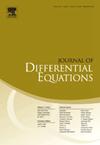Effective medium theory for Van-der-Waals heterostructures
IF 2.4
2区 数学
Q1 MATHEMATICS
引用次数: 0
Abstract
We derive the electromagnetic medium equivalent to a collection of all-dielectric nano-particles (enjoying high refractive indices) distributed locally non-periodically, precisely the medium is periodic with a unit cell composed of a cluster of multiple nano-particles, in a smooth domain Ω. Such distributions are used to model well-known structures in material sciences as the Van-der-Waals heterostructures. Since the nano-particles are all-dielectric, then the permittivity remains unchanged with respect to the background while the permeability is altered by this effective medium. This permeability is given in terms of three parameters. The first one is the polarization tensors of the used nano-particles. The second one is the averaged Magnetization matrix , where , is the identity matrix and is the unit cell. The third one is , where 's are locations of the local nano-particles distributed in the unit cell. This last tensor models the local strong interaction of the nano-particles. To our best knowledge, such tensors are new in both the mathematical and engineering oriented literature. This equivalent medium describes, in particular, the effective medium of 2 dimensional type Van-der-Waals heterostructures. These structures are 3 dimensional which are built as superposition of identical (2D)-sheets each supporting locally non-periodic distributions of nano-particles. An explicit form of this effective medium is provided for the particular case of honeycomb heterostructures.
At the mathematical analysis level, we propose a new approach to derive the effective medium when the subwavelength nano-particles are distributed non-periodically. The first step consists in deriving the point-interaction approximation, also called the Foldy-Lax approximation. The scattered field is given as a superposition of dipoles (or poles for other models) multiplied by the elements of a vector which is itself solution of an algebraic system. This step is done regardless of the way how the particles are distributed. As a second step, which is the new and critical step, we rewrite this algebraic system according to the way how these nano-particles are locally distributed. The new algebraic system will then fix the related continuous Lippmann-Schwinger system which, in its turn, indicates naturally the equivalent medium.
范-德-瓦尔斯异质结构的有效介质理论
本文章由计算机程序翻译,如有差异,请以英文原文为准。
求助全文
约1分钟内获得全文
求助全文
来源期刊
CiteScore
4.40
自引率
8.30%
发文量
543
审稿时长
9 months
期刊介绍:
The Journal of Differential Equations is concerned with the theory and the application of differential equations. The articles published are addressed not only to mathematicians but also to those engineers, physicists, and other scientists for whom differential equations are valuable research tools.
Research Areas Include:
• Mathematical control theory
• Ordinary differential equations
• Partial differential equations
• Stochastic differential equations
• Topological dynamics
• Related topics

 求助内容:
求助内容: 应助结果提醒方式:
应助结果提醒方式:


